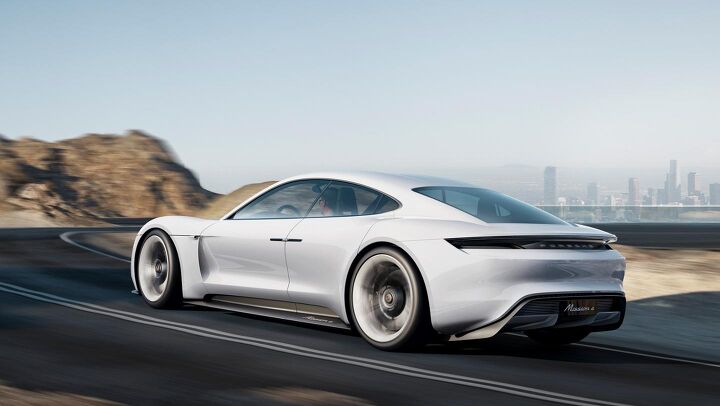Porsche Announces Mission E Tesla Fighter at Frankfurt, Drops Mic

Porsche announced its all-electric four-door concept sedan at the Frankfurt Auto Show, complete with 15-minute charging (to 80 percent) and 310-mile overall range. There’s also some holographic and emoticon blather, but we’ll get to that later.
According to Porsche, the Mission E will use two electric motors with a combined output of 600 horsepower to power the car up to 60 mph in 3.5 seconds. The car’s 800-volt charger would be a first for electric cars, and would help the car charge up to 80 percent in 15 minutes. According to Tesla, the Model S takes about 30 minutes to charge up to 80 percent for similar range.
Porsche didn’t say when (or even if) the car would make it into production, but it’s likely that something very much like it will be heading our way soon. Maybe this will be a new Panamera?
The concept car is full of concept-car goodies, according to Porsche. Four captains chairs? Check. A holo-deck information screen? Check. Emoticons and comically large (and two different sized) wheels? Check and check.
Porsche said its car would be capable of a sub-8 minute run at the Nurburgring Nordschleife and that its batteries could handle multiple, full-power runs. Wonderful.
Although much of the car is conceptual, it’s clear that Porsche is firing a shot across up Tesla’s nose with their battery tech. The Mission E’s 15-minute charge time is depending on the power source, of course, using a high-voltage draw that is roughly double what Tesla’s Supercharger network provides.
The quoted time to 80 percent — and not a full charge — is not uncommon for EVs. According to Chelsea Sexton, an EV expert who appeared in “Who Killed The Electric Car?” and who writes about EVs, Porsche’s claims for battery tech aren’t wholly out of left field — although the infrastructure to make it all work may not yet exist.
Batteries usually charge at their normal rate from 0 percent to 80 percent, she said, but automakers usually turn down the voltage, and consequently the rate of charge, between 80 percent to 100 percent to keep batteries from degrading. Increased heat due to high-voltage charging, especially when batteries are almost already fully charged, has been commonly thought to degrade Li-Ion batteries, although automakers say they’ve seen little degradation so far.
“At the moment, there are three DC fast charging connectors: Tesla, CHAdeMO (the Japanese/Korean manufacturers, generally speaking), and the SAE Combo (or “CCS”) connector, which the Americans and Germans all use. (It’s) worth noting that Ulrich Hackenberg of VW Group chairs the SAE committee, so no real chance that Porsche is going to deviate from that connector,” Sexton said. There’s no real chance that Porsche could partner with Tesla anytime soon, she added.
Porsche’s 800-volt charger may take a charge in 15 minutes, Sexton said, but the infrastructure needed to deliver that kind of power doesn’t yet exist. Current DC chargers operate between 50 and 100 kW, nowhere near potent enough to charge Porsche’s car in 15 minutes.
Porsche said its car could be charged at home, or on available public chargers, but didn’t say how long it would take to fully charge.

More by Aaron Cole
Latest Car Reviews
Read moreLatest Product Reviews
Read moreRecent Comments
- AMcA My theory is that that when the Big 3 gave away the store to the UAW in the last contract, there was a side deal in which the UAW promised to go after the non-organized transplant plants. Even the UAW understands that if the wage differential gets too high it's gonna kill the golden goose.
- MKizzy Why else does range matter? Because in the EV advocate's dream scenario of a post-ICE future, the average multi-car household will find itself with more EVs in their garages and driveways than places to plug them in or the capacity to charge then all at once without significant electrical upgrades. Unless each vehicle has enough range to allow for multiple days without plugging in, fighting over charging access in multi-EV households will be right up there with finances for causes of domestic strife.
- 28-Cars-Later WSJ blurb in Think or Swim:Workers at Volkswagen's Tennessee factory voted to join the United Auto Workers, marking a historic win for the 89- year-old union that is seeking to expand where it has struggled before, with foreign-owned factories in the South.The vote is a breakthrough for the UAW, whose membership has shrunk by about three-quarters since the 1970s, to less than 400,000 workers last year.UAW leaders have hitched their growth ambitions to organizing nonunion auto factories, many of which are in southern states where the Detroit-based labor group has failed several times and antiunion sentiment abounds."People are ready for change," said Kelcey Smith, 48, who has worked in the VW plant's paint shop for about a year, after leaving his job at an Amazon.com warehouse in town. "We look forward to making history and bringing change throughout the entire South." ...Start the clock on a Chattanooga shutdown.
- 1995 SC Didn't Chrysler actually offer something with a rearward facing seat and a desk with a typewriter back in the 60s?
- The Oracle Happy Trails Tadge










































Comments
Join the conversation
This car looks incredible.
If you could only drive computer mock-ups - wowsers!! And when it's done are they going to sign up for the super charging/sharing network, or are you going to search for a 110 outlet in the potted palms? Show me a car - otherwise it's a joke.